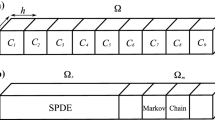Abstract
Reaction–diffusion processes on complex deforming surfaces are fundamental to a number of biological processes ranging from embryonic development to cancer tumor growth and angiogenesis. The simulation of these processes using continuum reaction–diffusion models requires computational methods capable of accurately tracking the geometric deformations and discretizing on them the governing equations. We employ a Lagrangian level-set formulation to capture the deformation of the geometry and use an embedding formulation and an adaptive particle method to discretize both the level-set equations and the corresponding reaction–diffusion. We validate the proposed method and discuss its advantages and drawbacks through simulations of reaction–diffusion equations on complex and deforming geometries.
Similar content being viewed by others
References
Adalsteinsson D, Sethian JA (2003) Transport and diffusion of material quantities on propagating interfaces via level set methods. J Comput Phys 185: 271–288
Baker R, Maini P (2007) A mechanism for morphogen-controlled domain growth. J Math Biol 54(5): 597–622
Bänsch E, Morin P, Nochetto RH (2005) A finite element method for surface diffusion: the parametric case. J Comput Phys 203: 321–343
Bergdorf M, Koumoutsakos P (2006) A Lagrangian particle-wavelet method. Multiscale Model Simul 5(3): 980–995
Bertalmio M, Cheng L-T, Osher S, Sapiro G (2001) Variational problems and partial differential equations on implicit surfaces. J Comput Phys 174: 759–780
Chaplain MAJ, Ganesh M, Graham IG (2001) Spatio-temporal pattern formation on spherical surfaces: numerical simulation and application to solid tumour growth. J Math Biol V42(5): 387–423
Chen S, Merriman B, Osher S, Smereka P (1997) A simple level set method for solving Stefan problems. J Comput Phys 135: 8–29
Enright D, Fedkiw R, Ferziger J, Mitchell I (2002) A hybrid particle level set method for improved interface capturing. J Comput Phys 183(1): 83–116
Harrison LG, Kolar M (1988) Coupling between reaction–diffusion prepattern and expressed morphogenesis, applied to desmids and dasyclads. J Theor Biol 130(4): 493–515
Harrison LG, Wehner S, Holloway DM (2001) Complex morphogenesis of surfaces: theory and experiment on coupling of reaction–diffusion patterning to growth. Faraday Discuss 120: 277–294
Hieber SE, Koumoutsakos P (2005) A Lagrangian particle level set method. J Comput Phys 210(1): 342–367
Holloway DM, Harrison LG (1999) Algal morphogenesis: modelling interspecific variation in Micrasterias with reaction–diffusion patterned catalysis of cell surface growth. Phil Trans R Soc Lond B 354: 417–433
Jiang G-S, Peng D (2000) Weighted ENO schemes for Hamilton–Jacobi equations. SIAM J Sci Comput 21(6): 2126–2143
Kaandorp JA, Sloot PMA, Merks RMH, Bak RPM, Vermeij MJA, Maier C (2005) Morphogenesis of the branching reef coral madracis mirabilis. Proc R Soc B 272: 127–133
Koch AJ, Meinhardt H (1994) Biological pattern formation: from basic mechanisms to complex structures. Rev Modern Phys 66(4): 1481–1507
Koumoutsakos P (2005) Multiscale flow simulations using particles. Annu Rev Fluid Mech 37(1): 457–487
Macklin P, Lowengrub J (2005) Evolving interfaces via gradients of geometry-dependent interior poisson problems: application to tumor growth. J Comput Phys 203: 191–220
Macklin P, McDougall S, Anderson A, Chaplain M, Cristini V, Lowengrub J (2009) Multiscale modelling and nonlinear simulation of vascular tumour growth. J Math Biol 58(4): 765–798
Madzvamuse A, Maini PK (2007) Velocity-induced numerical solutions of reaction–diffusion systems on continuously growing domains. J Comput Phys 225: 100–119
Milde F, Bergdorf M, Koumoutsakos P (2008) A hybrid model for three-dimensional simulations of sprouting angiogenesis. Biophys J 95(7): 3146–3160
Murray JD (2002) Mathematical biology I: an introduction. In: Interdisciplinary applied mathematics, vol 17. Springer, New York
Osher S, Fedkiw R (2003) Level set methods and dynamic implicit surfaces. In: Applied mathematical sciences, vol 153. Springer, New York
Pearson JE (1993) Complex patterns in a simple system. Science 261(5118): 189–192
Peng D, Merriman B, Osher S, Zhao H, Kang M (1999) A PDE-based fast local level set method. J Comput Phys 155: 410–438
Ruuth SJ, Merriman B (2008) A simple embedding method for solving partial differential equations on surfaces. J Comput Phys 227(3): 1943–1961
Sbalzarini IF, Hayer A, Helenius A, Koumoutsakos P (2006) Simulations of (an)isotropic diffusion on curved biological surfaces. Biophys J 90(3): 878–885
Sethian JA (1999) Fast marching methods. SIAM Rev 41(2): 199–235
Stone HA (1990) A simple derivation of the time-dependent convective-diffusion equation for surfactant transport along a deforming interface. Phys Fluids A 2(1): 111–112
Sussman M, Smereka P, Osher S (1994) A level set approach for computing solutions to incompressible two-phase flow. J Comput Phys 114(1): 146–159
Thompson DW (1942) On growth and form, 2nd edn. Cambridge University Press, Cambridge
Turing AM (1952) The chemical basis of morphogenesis. Philos Trans R Soc Lond Ser B 237(1/2): 37–72
Varea C, Aragon JL, Barrio RA (1999) Turing patterns on a sphere. Phys Rev E 60(4): 4588–4592
Xu J-J, Zhao H (2003) An eulerian formulation for solving partial differential equations along a moving interface. SIAM J Sci Comput 19(1–3): 573–594
Author information
Authors and Affiliations
Corresponding author
Rights and permissions
About this article
Cite this article
Bergdorf, M., Sbalzarini, I.F. & Koumoutsakos, P. A Lagrangian particle method for reaction–diffusion systems on deforming surfaces. J. Math. Biol. 61, 649–663 (2010). https://doi.org/10.1007/s00285-009-0315-2
Received:
Revised:
Published:
Issue Date:
DOI: https://doi.org/10.1007/s00285-009-0315-2




